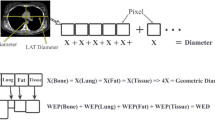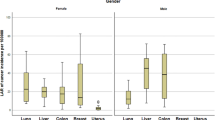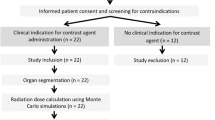Abstract
The objective of our study was to determine organ doses to estimate the lifetime attributable risk (LAR) of cancer incidence related to chest tomography simulations for Radiotherapy Treatment Planning (RTTP) using patient-specific information. Patient data were used to calculate organ doses and effective dose. The effective dose (E) was calculated by two methods. First, to calculate effective dose in a standard phantom, the collected dosimetric parameters were used with the ImPACT CT Patient Dosimetry Calculator and E was calculated by applying related correction factors. Second, using the scanner-derived Dose Length Product, LARs were computed using the US National Academy of Sciences (BEIR VII) model for age- and sex-specific risks at each exposure. DLP, CTDIvol, and scan length were 507 ± 143 mGy.cm, 11 ± 4 mGy, and 47 ± 7 cm, respectively. The effective dose was 10 ± 3 mSv using ImPACT patient dosimetry calculator software and 9 ± 2 mSv using the scanner-derived Dose Length Product. The LAR of cancer incidence for all cancers, all solid cancers and leukemia were 65 ± 29, 62 ± 27, 7 ± 2 cases per 100,000 individuals, respectively. Radiation exposure from the usage of CT for radiotherapy treatment planning (RTTP) causes non-negligible increases in lifetime attributable risk. The results of this study can be used as a guide by physicians to implement strategies based on the As Low As Reasonably Achievable (ALARA) principle that lead to a reduction dose without sacrificing diagnostic information.



Similar content being viewed by others
References
Ahmad SS, Duke S, Jena R, Williams MV, Burnet NG (2012) Advances in radiotherapy. BMJ 345:e7765
Albert JM (2013) Radiation risk from CT: implications for cancer screening. AJR Am J Roentgenol 201(1):W81–W87
Alkhorayef M (2018) Radiation risk from chest, abdomen and pelvis computed tomography investigations. J Radioanal Nucl Chem 318(1):661–665
Asadinezhad M, Bahreyni Toossi MT, Nouri M (2019) Diagnostic reference levels for computed tomography examinations in Iran: a nationwide radiation dose survey. Iranian J Med Phys 16(1):19–26
Bagherzadeh S, Jabbari N, Khalkhali HR (2018) Estimation of lifetime attributable risks (LARs) of cancer associated with abdominopelvic radiotherapy treatment planning computed tomography (CT) simulations. Int J Radiat Biol 94(5):454–461
Bagherzadeh S, Jabbari N, Khalkhali HR (2021) Radiation dose and cancer risks from radiation exposure during abdominopelvic computed tomography (CT) scans: comparison of diagnostic and radiotherapy treatment planning CT scans. Radiat Environ Biophys 60(4):579–589
Bayman E, Prestwich RJ, Speight R, Aspin L, Garratt L, Wilson S, Dyker KE, Sen M (2014) Patterns of failure after intensity-modulated radiotherapyin head and neck squamous cell carcinoma using compartmental clin-ical target volume delineation. Clin Oncol (r Coll Radiol) 26:636–642
Dzierma Y, Minko P, Ziegenhain F, Bell K, Buecker A, Rübe C, Jagoda P (2017) Abdominal imaging dose in radiology and radiotherapy—phantom point dose measurements, effective dose and secondary cancer risk. Phys Med 43:49–56
Einstein AJ, Sanz J, Dellegrottaglie S, Milite M, Sirol M, Henzlova M, Rajagopalan S (2008) Radiation dose and cancer risk estimates in 16-slice computed tomography coronary angiography. J Nucl Cardiol 15(2):232–240
Faletra FF, D’Angeli I, Klersy C, Averaimo M, Klimusina J, Pasotti E, Pedrazzini GB, Curti M, Carraro C, Diliberto R, Moccetti T, Auricchio A (2010) Estimates of lifetime attributable risk of cancer after a single radiation exposure from 64-slice computed tomographic coronary angiography. Heart 96(12):927–932
Ghetti C, Ortenzia O, Maddalo M, Altabella L, Sverzellati N (2020) Dosimetric and radiation cancer risk evaluation of high resolution thorax CT during COVID-19 outbreak. Phys Med 80:119–124
Huang R, Liu X, He L, Zhou PK (2020) Radiation exposure associated with computed tomography in childhood and the subsequent risk of cancer: A meta-analysis of cohort studies. Dose Response 18(2):1559325820923828
Huda W, Mettler FA (2011) Volume CT dose index and dose-length product displayed during CT: what good are they? Radiology 258:236–242
Huda W, Schoepf UJ, Abro JA, Mah E, Costello P (2011) Radiation-related cancer risks in a clinical patient population undergoing cardiac CT. AJR Am J Roentgenol 196(2):W159–W165
International Commission on Radiological Protection (ICRP Publication 87) (2000) Managing patient dose in computed tomography. Ann ICRP 30(4):7–45
International Commission on Radiological Protection 2007 The Recommendations of the International Commission on Radiological Protection ICRP publication 103. Ann ICRP. 2007:37(2–4):1–332.
Jessen KA, Panzer W, Shrimpton PC, Tosi G, Geleijns J (2000) EUR 16262: European guidelines on quality criteria for computed tomography. Office for Official Publications of the European Communities, Luxembourg, Luxembourg
Journy N, Ancelet S, Rehel JL, Mezzarobba M, Aubert B, Laurier D, Bernier MO (2014) Predicted cancer risks induced by computed tomography examinations during childhood, by a quantitative risk assessment approach. Radiat Environ Biophys 53(1):39–54
Kalra MK, Maher MM, Rizzo S, Kanarek D, Shepard JA (2004) Radiation exposure from chest CT: issues and strategies. J Korean Med Sci 19(2):159–166
Kim S, Yoshizumi TT, Frush DP, Toncheva G, Yin FF (2010) Radiation dose from cone beam CT in a pediatric phantom: risk estimation of cancer incidence. AJR Am J Roentgenol 194(1):186–190
Kritsaneepaiboon S, Jutiyon A, Krisanachinda A (2018) Cumulative radiation exposure and estimated lifetime cancer risk in multiple-injury adult patients undergoing repeated or multiple CTs. Eur J Trauma Emerg Surg 44(1):19–27
Kubo T, Lin PJ, Stiller W, Takahashi M, Kauczor HU, Ohno Y, Hatabu H (2008) Radiation dose reduction in chest CT: a review. AJR Am J Roentgenol 190(2):335–343
Lahham A, Masri HAL, Kameel S (2018) Estimation of female radiation doses and breast cancer risk from chest CT examinations. Radiat Prot Dosimetry 179(4):303–309
Maher MM, Kalra MK, Toth TL, Wittram C, Saini S, Shepard J (2004) Application of rational practice and technical advances for optimizing radiation dose for chest CT. J Thorac Imaging 19(1):16–23
Mahmoodi M, Chaparian A (2010) Organ doses, effective dose, and cancer risk from coronary CT angiography examinations. AJR Am J Roentgenol 214(5):1131–1136
Manssor E, Abuderman A, Osman S, Alenezi SB, Almehemeid S, Babikir E, Alkhorayef M, Sulieman A (2015) Radiation doses in chest, abdomen and pelvis CT procedures. Radiat Prot Dosimetry 165(1–4):194–198
McCollough CH, Christner JA, Kofler JM (2010) How effective is effective dose as a predictor of radiation risk? AJR Am J Roentgenol 194(4):890–896
McLaughlin PD, Chawke L, Twomey M, Murphy KP, O’Neill SB, McWilliams SR, James K, Kavanagh RG, Sullivan C, Chan FE, Moore N, O’Connor OJ, Eustace JA, Maher MM (2018) Body composition determinants of radiation dose during abdominopelvic CT. Insights Imaging 9(1):9–16
McNitt-Gray MF (2002) AAPM/RSNA physics tutorial for residents: topics in CT. Radiat Dose CT Radiographics 22(6):1541–1553
National Academy of Sciences Committee on the Biological Effects of Ionizing Radiation (BEIR) Report VII (2005) Health effects of exposure to low levels of ionizing radiations: time for reassessment? National Academy of Sciences, Washington (DC)
National Research Council (2006) Health risks from exposure to low levels of ionizing radiation: BEIR VII phase 2. The National Academies Press, Washington, DC
Palorini F, Origgi D, Granata C, Matranga D, Salerno S (2014) Adult exposures from MDCT including multiphase studies: first Italian nationwide survey. Eur Radiol 24:469–483
Pickhardt PJ (2018) CT colonography provides new insights into interval cancers. Lancet Gastroenterol Hepatol 3(5):292–294
Raman SP, Johnson PT, Deshmukh S, Mahesh M, Grant KL, Fishman EK (2013) CT dose reduction applications: available tools on the latest generation of CT scanners. J Am Coll Radiol 10:37–41
Salibi PN, Agarwal V, Panczykowski DM, Puccio AM, Sheetz MA (2014) Okonkwo DO (2014) Lifetime attributable risk of cancer from CT among patients surviving severe traumatic brain injury. AJR Am J Roentgenol 202(2):397–400
Sanderud A, England A, Hogg P, Fosså K, Svensson SF, Johansen S (2015) Radiation dose differences between thoracic radiotherapy planning CT and thoracic diagnostic CT scans. Radiography 22:107–111
Schauer DA, Linton OW (2009) NCRP Report No. 160 Ionizing radiation exposure of the population of the United States, medical exposure—are we doing less with more, and is there a role for health physicists? Health Phys 97(1):1–5
Tack D, Gevenois PA (2004) Radiation dose in computed tomography of the chest. JBR-BTR 87(6):281–288
Acknowledgements
We especially thank the Vice Chancellor for Research (VCR) of Kermanshah University of Medical Sciences, who approved and supported this project. We also thank the Shahid Rahimi Hospital for data collection and management.
Funding
No funding received.
Author information
Authors and Affiliations
Contributions
AMD, SB, AMSH, KKH, and FAM were responsible for the conceptualization and acquisition of the data. AMD and SB were responsible for the methodology. AMD, SB, and FAM were responsible for the writing, review, and/or revision of the manuscript. AMD, SB, AMSH, KKH, and FAM were responsible for the administrative, technical, or material support. All authors read and approved the final manuscript.
Corresponding author
Ethics declarations
Conflict of interests
All authors have no conflict of interests to declare.
Ethical approval
This study was approved by the ethics committee of Kermanshah University of Medical Sciences (Approval Number: IR.KUMS.REC.1399.1164).
Informed consent
Written informed consent was obtained from all the participants who voluntarily accepted to participate in the study.
Additional information
Publisher's Note
Springer Nature remains neutral with regard to jurisdictional claims in published maps and institutional affiliations.
Rights and permissions
Springer Nature or its licensor (e.g. a society or other partner) holds exclusive rights to this article under a publishing agreement with the author(s) or other rightsholder(s); author self-archiving of the accepted manuscript version of this article is solely governed by the terms of such publishing agreement and applicable law.
About this article
Cite this article
Derikvand, A.M., Bagherzadeh, S., MohammadSharifi, A. et al. Estimation of cancer risks due to chest radiotherapy treatment planning computed tomography (CT) simulations. Radiat Environ Biophys 62, 269–277 (2023). https://doi.org/10.1007/s00411-023-01025-4
Received:
Accepted:
Published:
Issue Date:
DOI: https://doi.org/10.1007/s00411-023-01025-4




